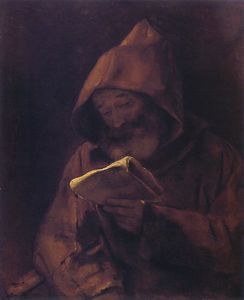More Thoughts on Lectio Divina
 I think that the best book I ever read on lectio divina is one by Denys Gorce. I read it back in 1972 and I think it was entitled, La lectio divina dans le milieu de saint Jérôme. It left its mark on me. Then there was William of St–Thierry’s classic, The Golden Epistle or The Letter to the Brothers of Mont–Dieu, and Guigo the Carthusian’s Scala Claustralium, The Ladder of Monks.
I think that the best book I ever read on lectio divina is one by Denys Gorce. I read it back in 1972 and I think it was entitled, La lectio divina dans le milieu de saint Jérôme. It left its mark on me. Then there was William of St–Thierry’s classic, The Golden Epistle or The Letter to the Brothers of Mont–Dieu, and Guigo the Carthusian’s Scala Claustralium, The Ladder of Monks.
I find it a little disquieting that lectio divina has become a trendy phrase in some circles. There are a lot of pop–spirituality publications in Catholic bookstores that claim to present an introduction to lectio divina. Most of them, especially those written from outside the monastic tradition, fall short of doing that. Folks use the expression lectio divina without knowing what it really means. I have heard it used to describe reflections on the Word of God in a group, meditative reading of any pious text, and a systematic cover–to–cover reading of the Bible. It is none of these things. So, what is lectio divina?
The primary form of lectio divina is corporate and ecclesial; it is the Church herself hearing the Word, repeating the Word, praying the Word, and abiding in the Word, all within the context of the Sacred Liturgy (Divine Office and Mass). The corporate lectio divina of the Church, be it within the Divine Office or the Mass, has a Eucharistic finality. The movement is always from the ambo to the altar.
The secondary form of lectio divina is solitary and personal; it derives from the first and even imitates its pattern. It prepares one for the Sacred Liturgy and prolongs it.
The solitary and personal form of lectio divina is:
1. A kind of liturgy of the Word celebrated in solitude.
2. Patterned after the Church’s corporate lectio divina: the Night Office (Vigils) with its rhythm of reading, responsory, and prayer, and after the Liturgy of the Word of the Mass.
3. Honours the discipline of obedience to the liturgical lectionary.
4. Best done in the same place and at the same time each day.
Lectio divina has its own inner rhythm:
1. Lectio, that is the sacred text read aloud in order to become the Word heard.
2. Meditatio, the repetition of the Word. By dint of repetition the Word heard descends into the heart where it becomes —
3. Oratio, that is, the Word prayed. The very Word by which God speaks to me becomes the Word by which I lift my mind and heart to Him.
4. The Word prayed becomes the Word reserved in the secret tabernacle of the heart, and the Eucharist of the Intelligence. The indwelling Word draws the soul into the prayer of loving silence and adoration. Tacere et adorare. Be still and adore.
Lectio divina is also the soul seeking the Face of Christ, so as to read on His Face all the secrets of His Heart. One who loves learns to discern the Face of the Bridegroom Christ through the mystical trellis that is the sacred text. “Behold, there He stands behind our wall, gazing in at the windows, looking through the lattice. My beloved speaks and says to me: ‘Arise, my love, my fair one, and come away'” (Ct 2:9–10).
A few recommendations:
Obey the liturgical lectionary; bend to its discipline. Each day read, not what you choose to read, but what Mother Church sets before you in her liturgy.
Do your lectio divina in your Bible and not in a missal or missalette.
The monastic custom is to begin lectio divina kneeling.
Invoke the Holy Spirit and the Blessed Virgin Mary, the Sanctuary of the Holy Spirit and the Mother of the Word.
Kiss the sacred page reverently.
Still kneeling, read the first line or two. Then sit or stand as you wish.
Lectio. Read the appointed text audibly. Text becomes Word when you hear it.
Meditatio. Repeat it. Copy it out. Memorize a phrase or two.
Oratio. When the Word begins to rise in your heart, send it back to God whence it came.
Use the words of God to speak to God.
Let the Word lift your heart and mind into the presence of the Divine Majesty.
Contemplatio. Make of your heart a tabernacle for the indwelling Word.
Remain in adoring silence and in love.
End with the Gloria Patri recited slowly and deliberately, and with your customary invocations to Our Lord, to the Mother of God, and to the saints.

Thank you for your writings on St. Jerome and Lectio Divina, a welcome sight to the eyes of the mind and heart…
…. the mystical trellis that is the sacred text.